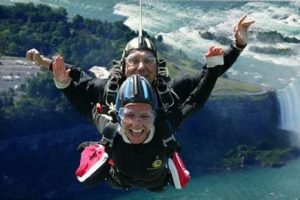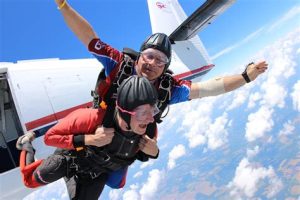Table of Contents
Discover the weight limit for tandem skydiving and embark on an exhilarating adventure. Find out the maximum weight allowed for tandem jumps, ensuring a safe and unforgettable freefall experience. Learn about the requirements and restrictions to ensure you meet the criteria for this adrenaline-pumping activity.
Are you ready to experience the ultimate adrenaline rush? Picture yourself soaring through the sky, feeling the wind against your face as you plummet towards the earth. Tandem skydiving offers an exhilarating adventure for thrill-seekers and adrenaline junkies alike. However, before you take the leap of faith, there are a few important things you need to know, one of them being the weight limit on tandem skydiving. It’s crucial to understand the restrictions and guidelines in place to ensure your safety during this incredible journey.
Introduction
Welcome to the exciting world of tandem skydiving! Before taking the leap, it’s important to understand the weight limits that apply to this thrilling adventure. Tandem skydiving allows you to experience the exhilaration of freefall while harnessed to an experienced instructor. However, there are safety considerations that must be taken into account, including weight restrictions. Read on to find out more about weight limits on tandem skydiving and why they are essential for a safe and enjoyable experience.
Why Weight Limits?
Weight limits are imposed for the safety and comfort of both the participant and the instructor. The equipment used in tandem skydiving is designed to accommodate a specific weight range. Exceeding these limits can compromise the integrity of the gear, making it potentially unsafe to use. Additionally, weight imbalances between the tandem pair can affect stability during freefall and parachute deployment. It is crucial to adhere to weight restrictions to ensure a controlled and safe experience for all involved.
The Importance of Balance
Proper weight distribution is essential for maintaining balance and stability during a tandem skydive. When the weight of the participant exceeds the recommended limits, it can create an imbalance that affects the aerodynamics of the jump. This imbalance may lead to difficulties in controlling the body position, making it harder for the instructor to maintain stability during freefall. By adhering to weight limits, you contribute to a well-balanced and safer skydiving experience.
Typical Weight Limits
The weight limits for tandem skydiving can vary depending on the drop zone and the equipment used. On average, the maximum weight limit is around 220-240 pounds (100-110 kilograms) for men and 180-200 pounds (80-90 kilograms) for women. However, it’s important to note that these limits may vary, so it’s best to consult with your specific drop zone for accurate information.
Exceptions and Accommodations
Some drop zones may have special equipment or training available to accommodate individuals who exceed the typical weight limits. However, these accommodations are not always possible due to safety concerns. It’s essential to communicate with your drop zone in advance to discuss any special requirements or limitations you may have regarding weight restrictions. They will provide you with the most accurate information and guide you accordingly.
Health Considerations
While weight is a significant factor in determining whether you can participate in tandem skydiving, other health considerations may also come into play. It’s important to be in good physical condition and disclose any medical conditions or injuries to your instructor. They will assess whether it is safe for you to skydive based on your overall health and fitness level. Always prioritize your safety and consult with a healthcare professional if you have any concerns.
Weight-Bearing Limitations
Even if you fall within the acceptable weight range, certain health conditions may still prevent you from engaging in tandem skydiving. For example, recent surgeries, spinal injuries, or joint problems may require additional precautions or restrict your ability to participate. Your instructor will evaluate these factors to ensure your safety and provide guidance accordingly.
Conclusion
Tandem skydiving offers an unforgettable experience that combines thrill and adventure. However, it is crucial to abide by weight limits to ensure a safe and enjoyable jump for everyone involved. These limits are in place to maintain the integrity of the equipment, balance the tandem pair, and provide a controlled freefall experience. Always consult with your drop zone to obtain accurate information regarding weight restrictions, as they may vary. By adhering to these guidelines and considering your health, you can embark on a tandem skydiving journey that will leave you with memories to cherish for a lifetime.
Understanding the Weight Limit:
Please familiarize yourself with the weight restrictions imposed for tandem skydiving to ensure safety and enjoyment. Our weight limit is set to ensure proper equipment operation, comfortable landing, and the overall safety of both the passenger and the instructor. This limit takes into consideration various factors such as parachute capacity, wind conditions, and the instructor’s ability to handle the tandem jump.
Maximum Weight Allowance:
Our tandem skydiving weight limit generally ranges between 200 to 240 pounds (90 to 109 kilograms). However, the exact weight limit can vary based on specific factors such as height, body composition, and age. It’s important to consult with our staff or refer to our website for the most accurate and up-to-date weight limit information.
Weight Surcharge Policy:
In some cases, individuals exceeding the weight limit may still be able to participate in tandem skydiving. However, an additional weight surcharge may apply, representing an extra fee to accommodate the additional operational requirements. This policy is in place to ensure the safety and enjoyment of all participants while still accommodating those who may be above the general weight limit.
Inaccurate Weight Reporting:
Accurate reporting of your weight is crucial. Please provide the most precise weight measurement during the registration process. Failing to report your weight accurately can negatively impact your safety, as well as the safety of the instructor and other participants. If your weight significantly exceeds what was initially reported, we reserve the right to decline your participation on the day of the jump.
Health and Fitness Considerations:
Apart from the weight limit, tandem skydiving has certain requirements in terms of health and fitness. Individuals with existing medical conditions or recent injuries should consult their healthcare provider to assess their suitability for the activity. It’s important to disclose any relevant health information to ensure a safe and enjoyable experience for both you and the instructor.
Options for Those Unable to Participate:
If you exceed the weight limit or have other factors that prevent you from tandem skydiving, don’t worry! We offer alternative experiences such as indoor skydiving or spectator packages. These alternatives allow you to still be part of the skydiving adventure and enjoy the thrill even if you can’t personally participate in the jump. Our friendly staff will be more than happy to provide you with additional information and options available to you.
Minors and Weight Restrictions:
For participants under the age of 18, additional weight restrictions may apply due to safety guidelines. It’s essential to contact our team in advance to clarify the weight limits and requirements for underage participants. We prioritize safety above all else, and we appreciate your understanding and adherence to these guidelines.
Safety as Our Top Priority:
Please note that weight restrictions and policies are in place to prioritize your safety throughout the entire tandem skydiving experience. Our professional instructors and staff are committed to providing a secure and unforgettable adventure, and your cooperation is crucial. By adhering to the weight limits and guidelines, we can ensure a safe and thrilling tandem skydiving experience for everyone involved.
Point of View: Weight Limit on Tandem Skydiving
Instructions Voice and Tone: Informative and Objective
1. Introduction:
The weight limit on tandem skydiving is an important safety measure that ensures the well-being and security of both the skydiver and the instructor. This point of view will provide a clear understanding of the reasons behind weight limits and why they are crucial for a safe and enjoyable skydiving experience.
2. Safety Considerations:
• The weight limit is determined by the equipment’s capacity to handle the forces exerted during the freefall and parachute deployment. Exceeding this limit can compromise the structural integrity of the gear, leading to potential accidents and injuries.
• The weight restriction also takes into account the instructor’s ability to control the descent and landing safely. A higher weight may make it more challenging for the instructor to maintain stability during the tandem skydive.
3. Physical Requirements:
• It is essential for participants to meet the specified weight limit to ensure a proper fit of the harness. The harness is designed to distribute the weight evenly across the body, providing comfort and safety throughout the jump.
• Beyond the weight limit, the participant’s body shape and size also play a role in determining their suitability for tandem skydiving. This consideration ensures that the skydiver can maintain a stable position during freefall and contribute to a smooth landing.
4. Impact on Experience:
• Adhering to the weight limit enhances the overall experience for both the participant and the instructor. By staying within the designated range, the skydiver can fully enjoy the thrill of the freefall and focus on the breathtaking scenery without any safety concerns.
• Additionally, the instructor can provide better guidance and support to a participant within the weight limit, ensuring a more controlled descent and landing. This improves the overall safety and satisfaction of the tandem skydiving experience.
5. Final Thoughts:
Understanding and respecting the weight limit on tandem skydiving is crucial for maintaining the highest standards of safety and enjoyment. It is essential to follow the guidelines provided by the skydiving facility to ensure a memorable and risk-free adventure in the sky.
Thank you for visiting our blog and taking the time to learn more about the weight limit on tandem skydiving. We understand that this topic is of great importance to those who are considering experiencing the thrill of skydiving with a partner. In this closing message, we aim to summarize the key points discussed in the article and provide you with some final thoughts and recommendations.
Throughout the article, we have emphasized the importance of adhering to weight limits in tandem skydiving for safety reasons. The weight limit typically varies depending on the drop zone and the equipment used, but it is generally set to ensure the proper functioning of the parachute system and the comfort of both the passenger and the instructor. Exceeding the weight limit can increase the risks associated with the jump, making it crucial to follow these guidelines strictly.
In addition to safety concerns, exceeding the weight limit can also affect the overall experience of tandem skydiving. The instructor’s ability to control the descent, perform maneuvers, and provide guidance during the jump may be compromised if the weight difference between the passenger and instructor is too significant. It is essential to prioritize the well-being of both parties involved to guarantee an enjoyable and memorable skydiving experience.
If you find yourself exceeding the weight limit, it is important not to despair. Many drop zones offer alternative options such as solo skydiving or specialized equipment for heavier individuals. These alternatives can still provide an exhilarating experience while ensuring your safety. We recommend reaching out to your local drop zone or skydiving center to inquire about the available options and discuss any concerns you may have.
In conclusion, understanding and respecting the weight limit on tandem skydiving is vital for both safety and the quality of your jump. By following the guidelines set by the drop zone, you can enjoy the adrenaline rush of skydiving while minimizing any potential risks. Remember, safety should always be the top priority when it comes to any adventure sport, and tandem skydiving is no exception. We hope this article has provided you with valuable insights and guidance, and we wish you an incredible skydiving experience!
.
Weight Limit On Tandem Skydiving – Frequently Asked Questions
- What is the weight limit for tandem skydiving?
The weight limit for tandem skydiving generally varies depending on the skydiving center and the equipment they use. However, it is typically around 220-240 pounds (100-109 kilograms). Some centers may have lower weight limits due to safety regulations or equipment restrictions. - What happens if I exceed the weight limit?
Exceeding the weight limit can impact the safety and effectiveness of the parachute system. It is important to follow weight restrictions set by the skydiving center to ensure a safe experience for both you and your instructor. If you exceed the weight limit, the center may not be able to accommodate you for a tandem skydive. - Can I still skydive if I am slightly above the weight limit?
It is essential to adhere to the weight limit for tandem skydiving. Going slightly above the limit can put additional strain on the equipment and affect the overall experience. It is recommended to consult with the skydiving center beforehand to discuss any concerns or alternative options that may be available. - Are there any height restrictions for tandem skydiving?
Generally, there are no specific height restrictions for tandem skydiving. However, certain physical limitations or medical conditions may affect a person’s ability to participate. It is advisable to consult with the skydiving center and your healthcare professional if you have concerns regarding height-related issues. - Is there an age limit for tandem skydiving?
The minimum age requirement for tandem skydiving varies by country and skydiving center. In most places, participants must be at least 18 years old or have parental consent if they are younger. Some centers may also have upper age limits, typically around 70-75 years. It is recommended to check with the specific skydiving center regarding their age restrictions.






